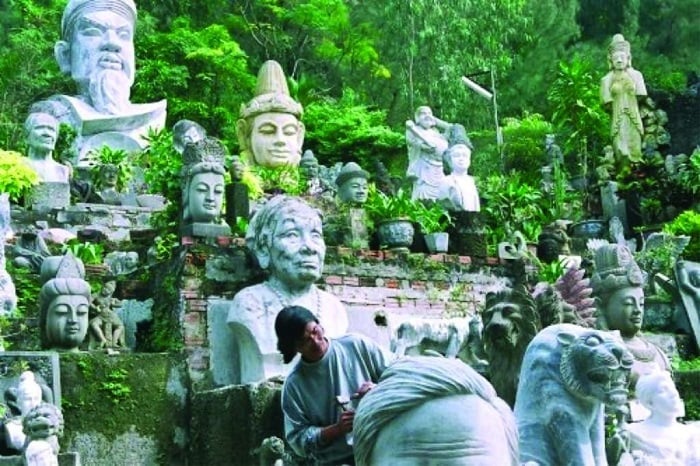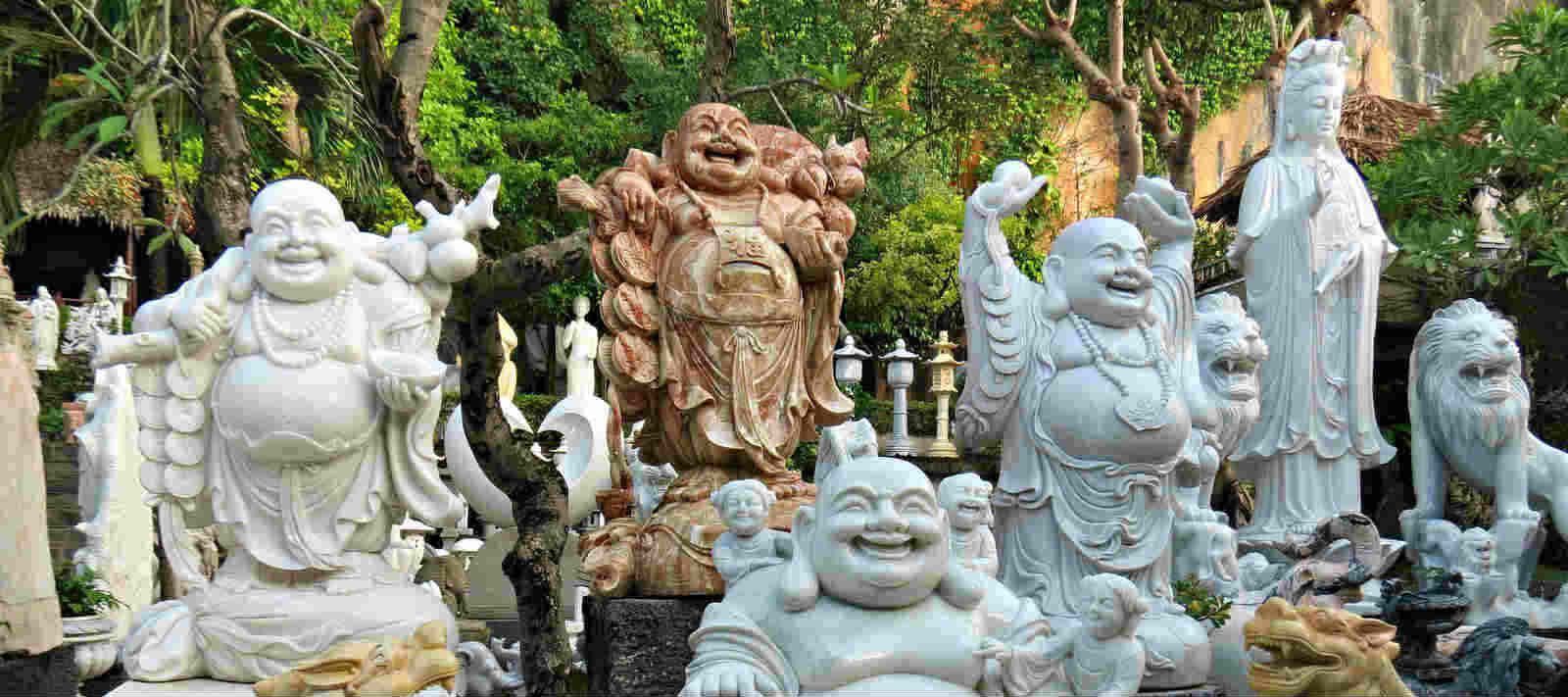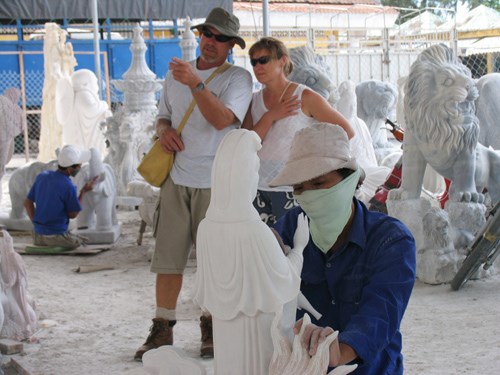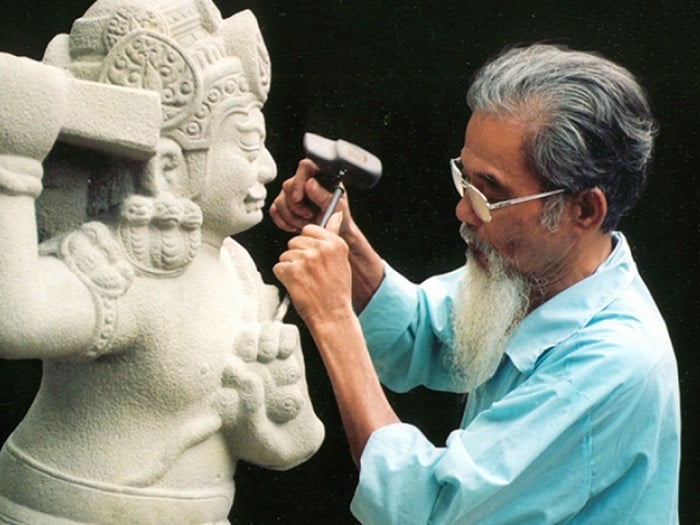About Non Nuoc Stone Carving Village
THE BEAUTY OF NON NUOC STONE ART VILLAGE, DA NANG

on Nuoc Stone Carving Village in Da Nang is one of the oldest traditional craft villages in Da Nang. Located in Hai Hoa Ward, right at the foot of the famous Ngu Hanh Son Mountain, the village is also an indispensable stop on the tour of Da Nang city.
History of Non Nuoc stone carving village
According to Le Quy Don's "Phu Bien Tap Luc", Non Nuoc stone carving village was formed in the 18th century by a native of Thanh Hoa named Huynh Ba Quat. Being the son of a family with a tradition of stone carving, Huynh Ba Quat was very knowledgeable about the profession of selecting stone veins as well as sculpting. In the first half of the 17th century, when he migrated to the foot of Non Nuoc mountain to make a living, realizing that this cluster of marble mountains was valuable, he worked hard to exploit and carve them into tombstones, millstones, pepper and medicine mortars and many other items to sell to residents in the surrounding area. Initially, the stone carving work was done during the off-season to earn extra income. Later, realizing the benefits, he taught it to his children and relatives in the area, gradually forming a traditional craft village.

Products at Non Nuoc Stone Carving Village
Under the Nguyen Dynasty, the stone carving industry flourished. In order to prevent the residents of Quan Khai village – a stone carving village at the foot of Non Nuoc mountain – from exploiting stone on a large scale, destroying the beauty of Ngu Hanh Son Da Nang , many directives were issued to prohibit the exploitation of stone for handicrafts and sculptures for sale outside the province.
Regarding the formation of the Non Nuoc Da Nang stone carving village, many stories about Huynh Ba Quat have been passed down by word of mouth among the people. Accordingly, Huynh Ba Quat had a twin brother who was also talented in choosing stone patterns and carving, but not as talented as him. The elder brother Huynh Ba Quat made common products that were easily confused with others. He, on the other hand, liked to make things that were close to life, such as a buffalo chewing grass, a village girl carrying a basket of fruit, etc. Therefore, although it was difficult to distinguish between the two, when looking at the products, the people in the area immediately knew which was the elder brother's and which was the younger brother's. The good news spread far and wide, and one day, the French ambassador brought a portrait of the French emperor to order Huynh Ba Quat. However, he politely refused, saying that he could only make familiar things, and the French emperor was too unfamiliar for him to do. Knowing that Huynh Ba Quat was secretly opposing, the ambassador ordered his arrest. He planned to have his horse trample his hands the next morning so that he could no longer make any products. However, that night, his brother secretly swapped them. That is how the Non Nuoc stone carving village came to be today.
Development and products of Non Nuoc stone carving village
To make a beautiful product, artisans have to spend a lot of effort.
In 1975, the Non Nuoc Stone Sculpture Cooperative was established. In 2006, the Non Nuoc Stone Sculpture Traditional Craft Village Association was established. Thanks to activities to promote and preserve the craft village, the Non Nuoc Stone Sculpture Village now has more than 20 enterprises, 430 production facilities and more than 4,500 workers and has become one of the most attractive tourist destinations in Da Nang .
The products of the craft village are very diverse, from everyday items such as mortars, cups, pestles, bowls, stone teapots... to statues of Buddha, Quan Am, Venus, businessmen, sphinxes, lions, tigers, leopards, eagles... With quality and sophistication, the products of the craft village are not only supplied to tourists and domestic establishments but also exported to many other countries such as the US, Australia, Japan... In addition, many establishments also organize vocational training classes for children to study at sculpture and fine arts schools and invite famous artists to create designs and styles to serve customer needs.
In 2014, the Non Nuoc stone carving village was recognized by the Ministry of Culture, Sports and Tourism as a national intangible cultural heritage. Thanks to that, the village is increasingly known to domestic and foreign tourists. According to statistics, the village's products are mainly sold directly to tourists, the remaining 30% are produced according to domestic and foreign orders.

Non Nuoc handicraft village is a familiar destination when traveling to Da Nang.
Joining the Da Nang tour and visiting a stone handicraft production facility in the craft village, visitors will be amazed by the richness and diversity of the items here. From small finger-sized statues to life-sized statues, all are vivid and extremely sophisticated. That is why, after a tour, every visitor must buy a few items to decorate as well as give to relatives.
In addition, visitors can also visit the Thach Nghe To Su Temple in Hoa Hai Ward, Ngu Hanh Son District. On the 6th day of the first lunar month every year, artisans in the craft village will organize the death anniversary of the Non Nuoc stone carving craft to pay tribute to the person who gave birth to the craft village.
Today, after more than 400 years of existence, the Non Nuoc stone carving village in Da Nang still exists and maintains its strong vitality. This is not only the result of the efforts of artisans in the craft village and local authorities, but also the great support and patronage from tourists.
